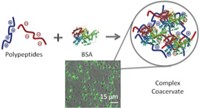Advertisement
Grab your lab coat. Let's get started
Welcome!
Welcome!
Create an account below to get 6 C&EN articles per month, receive newsletters and more - all free.
It seems this is your first time logging in online. Please enter the following information to continue.
As an ACS member you automatically get access to this site. All we need is few more details to create your reading experience.
Not you? Sign in with a different account.
Not you? Sign in with a different account.
ERROR 1
ERROR 1
ERROR 2
ERROR 2
ERROR 2
ERROR 2
ERROR 2
Password and Confirm password must match.
If you have an ACS member number, please enter it here so we can link this account to your membership. (optional)
ERROR 2
ACS values your privacy. By submitting your information, you are gaining access to C&EN and subscribing to our weekly newsletter. We use the information you provide to make your reading experience better, and we will never sell your data to third party members.
Biological Chemistry
Peptide Fools Immune System Into Allowing Nanoparticles To Stick Around
Drug Delivery: ‘Don’t eat me’ signal allows nanoparticles to evade detection
by Elizabeth K. Wilson
February 21, 2013
| A version of this story appeared in
Volume 91, Issue 8

The immune system sometimes works too well, identifying useful things such as drugs, sutures, or pacemakers as unwanted invaders. Now, researchers have developed an artificial peptide modeled on a human protein that forestalls immune attack. Foreign particles and materials tagged with the peptide stay in the body without causing inflammatory responses, the team reports (Science, DOI: 10.1126/science.1229568).
University of Pennsylvania biophysical engineering professor Dennis E. Discher, graduate student Pia L. Rodriguez, and their colleagues modeled their peptide on the human protein CD47. This protein binds to a receptor known as SIRPα on the surface of macrophages, the immune cells responsible for engulfing invaders. CD47’s interaction with this receptor sends a signal to the macrophage to leave it alone.
The authors used computational techniques to design a 21-amino-acid peptide, which they call Self, that has the same SIRPα-binding characteristics as the larger CD47.
To test their peptide’s efficacy, the group attached the peptide to virus-sized polystyrene beads. They then injected them into mice genetically engineered to have humanlike SIRPα receptors. Mice injected with beads boasting the Self peptide had up to four times as many beads left in their systems after 20–30 minutes than did mice injected with unlabeled beads.
Discher’s group first discovered the “don’t eat me” signal triggered by CD47-SIRPα binding in 2008. When other researchers reported the structure of human CD47 bound to SIRPα, Discher’s group was then able to move forward with a designed mimic of the shielding protein.
Human CD47 can vary from person to person by a few amino acids, but the Self peptide is universal among humans. Anyone’s macrophages will accept it, Discher tells C&EN. It is also quickly synthesized. This work sets the stage for numerous experiments involving nanoparticles that deliver drugs and image tumors.
Discher “is looking ahead to potentially using this as a component of a therapeutic strategy where a drug is linked to a nanoparticle,” says Jayne Danska, professor in the immunology and medical biophysics departments at the University of Toronto. “It’s really high-quality work.”



Join the conversation
Contact the reporter
Submit a Letter to the Editor for publication
Engage with us on Twitter